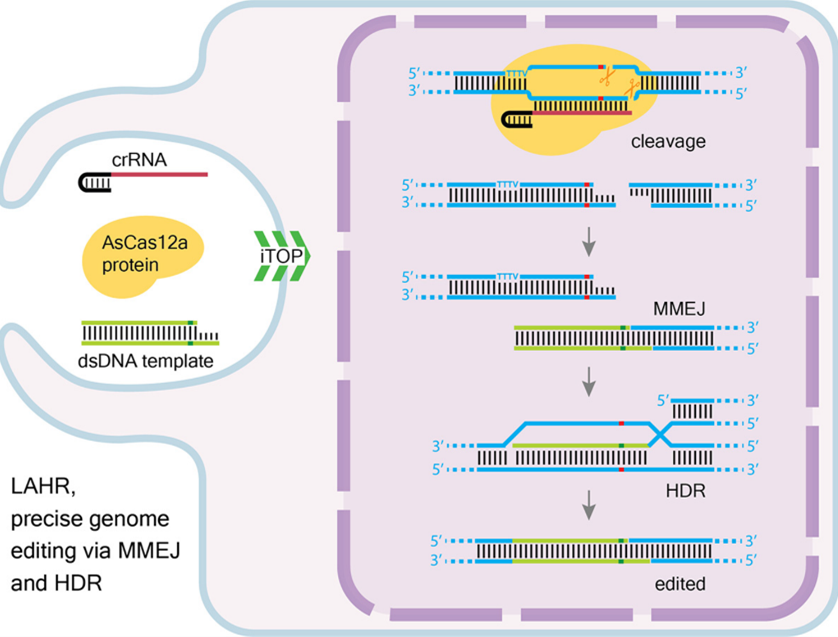LAHR: IMPROVED GENOME EDITING ACCURACY AND EFFICIENCY

Summary
The present invention, termed Ligation-Assisted Homologous Recombination (LAHR), represents an innovative genome editing strategy that combines the genome editing capabilities of CRISPR/Cas12a technology with the high-fidelity of a dual repair mechanism. This method significantly enhances the efficiency and precision of introducing specific nucleotide substitutions while minimizing off-target effects, offering a promising approach for gene therapy and biomedical research.
Background
Genome editing technologies, particularly CRISPR/Cas systems, have revolutionized molecular biology, providing unprecedented control over the genome. The CRISPR/Cas12a system, recognized for its unique PAM requirements and cleavage properties, generates specific 5′ overhangs, facilitating targeted genome editing. Despite advancements, challenges in editing efficiency and precision persist, particularly when introducing specific nucleotide changes.
Technology
LAHR employs the CRISPR/Cas12a system to create a double-strand break (DSB) with 5′ overhangs near the target mutation. A specially designed double-stranded DNA repair template, containing a complementary 5′ overhang and a short homologous arm, is then introduced. This template engages with the DSB through a resection-independent MMEJ pathway, followed by HDR for target mutation correction. The method has been validated in various cell lines, demonstrating superior efficiency compared to traditional HDR methods, especially in contexts where Cas9 HDR is less effective.
Research and Development
Initial experiments validated LAHR's effectiveness in correcting specific mutations in the EGFP gene within reporter cell lines, demonstrating superior efficiency compared to standard HDR techniques utilizing ssODN templates. Comparative studies further revealed that LAHR matches or exceeds the performance of SpCas9-mediated HDR, especially in scenarios where SpCas9 is limited by PAM sequence requirements.
Investigations into LAHR's mechanics showed the first precise genome editing tool that deploys both the resection-independent MMEJ and HDR mechanisms for precise nucleotide insertion. Additional research highlighted the critical role of homologous arm length and mutation-to-cleavage site distance in optimizing LAHR's editing efficiency.
The technology was successfully applied to introduce precise edits in endogenous genes, including correcting a mutation in the B2M gene and introducing mutations in the ALK and CACNA1D genes, demonstrating LAHR's applicability and efficiency in a real genomic context.
Value proposition
The key value propositions of this innovative technology are:
- Enhanced Precision and Efficiency: LAHR outperforms traditional CRISPR/Cas9 methods in genome editing, offering greater precision and efficiency for accurate genetic modifications.
- Versatility in Application: The technology's ability to effectively target and edit endogenous genes showcases its versatility, making it applicable across various research and therapeutic contexts.
- Overcoming PAM Sequence Limitations: LAHR provides a robust alternative when CRISPR/Cas9 is limited by PAM sequence constraints, expanding the range of genomic targets.
- Dual Repair Mechanisms: Utilizing MMEJ and HDR pathways, LAHR ensures high-fidelity editing, minimizing off-target effects and enhancing the success rate of genetic modifications.
- Potential for Therapeutic Advancements: The precision and adaptability of LAHR hold significant promise for the development of gene therapies, offering new avenues for treating genetic disorders with high accuracy and reduced risk.
The CRISPR and Cas Genes Market, valued at $2.57 billion in 2022, is forecasted to expand at a CAGR of 17.15%, with a value of approximately $9.12 billion in 2030 (Grand View Research).
Team
The development of LAHR technology is led by Professor Niels Geijsen at LUMC, where he leads a team of experts specializing in developmental biology, regenerative medicine, and synthetic biology.
Intellectual property
The LAHR technology is protected by the patent "Method of editing nucleic acid" (PCT/EP2022/084232), which covers its unique genome editing approach. The patent process began in December 2021 and advanced to international filing in December 2022, with national phase entry expected by mid-2024.
Key benefits
- LAHR technology utilizes a novel CRISPR/Cas12a-based method for precise genome editing.
- Enhances precision and efficiency in genome editing over traditional methods.
Patent status
- Patent filed in Europe, US, and Canada.



